In 2024, the Bitcoin halving, ETF approvals, and Trump's victory drove market growth, and the cryptocurrency market is expected to continue expanding in 2025, particularly propelled by Bitcoin, altcoins, and the tokenization of real-world assets.
Written by: CoinGecko
Translation: Plain Language Blockchain
As we step into 2025, looking back at 2024, the cryptocurrency market underwent significant transformations and developments. The strong growth of Bitcoin and the rise of altcoins rapidly evolved the entire industry. Let’s delve into the key trends of 2024 and look ahead to the market dynamics of 2025.
1. Key Trends of 2024: Bitcoin and Altcoins
1) Bitcoin Halving Sparks Bull Market
In 2024, the Bitcoin halving event once again became a catalyst for a bull market, with Bitcoin's price soaring by 146%, showcasing impressive performance. The halving event occurs approximately every four years, reducing the rewards miners receive for validating transactions by half. This reduction in the supply of new Bitcoin often triggers significant market volatility due to its scarcity.
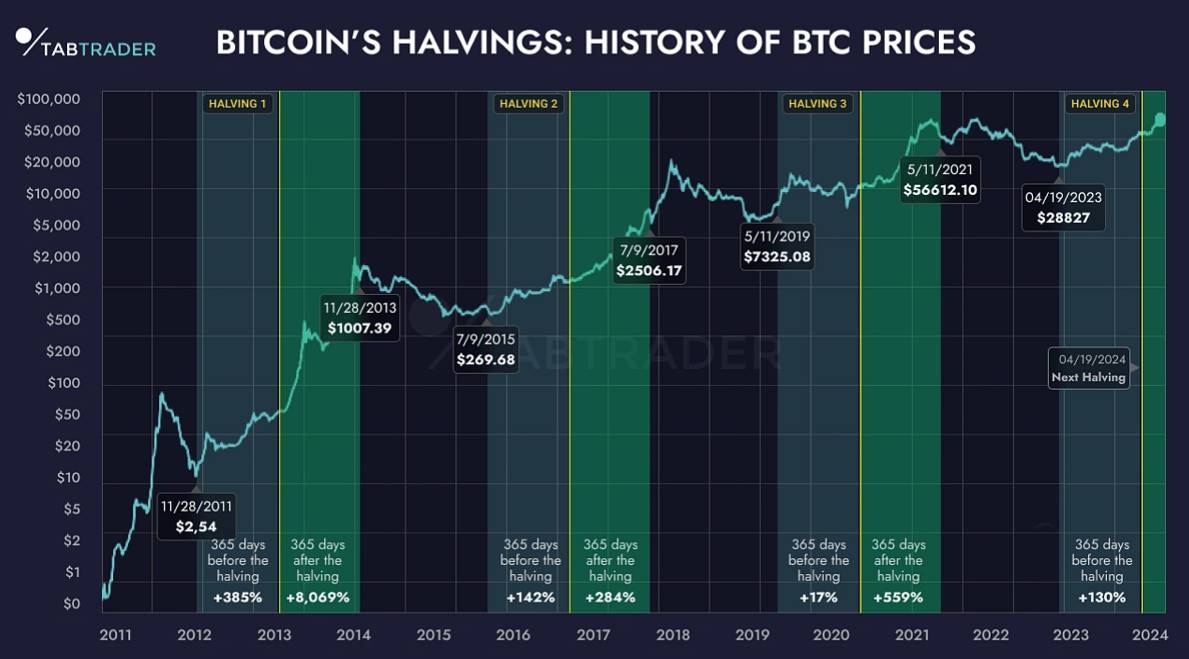
Historically, Bitcoin's price has typically experienced significant growth following each halving. For example, after the halving in 2016, Bitcoin's price skyrocketed from $650 to $20,000 in just over a year. Similarly, after the 2020 halving, Bitcoin rose from around $8,000 to a peak of $69,000 in 2021.
2) Approval of Bitcoin and Ethereum ETFs
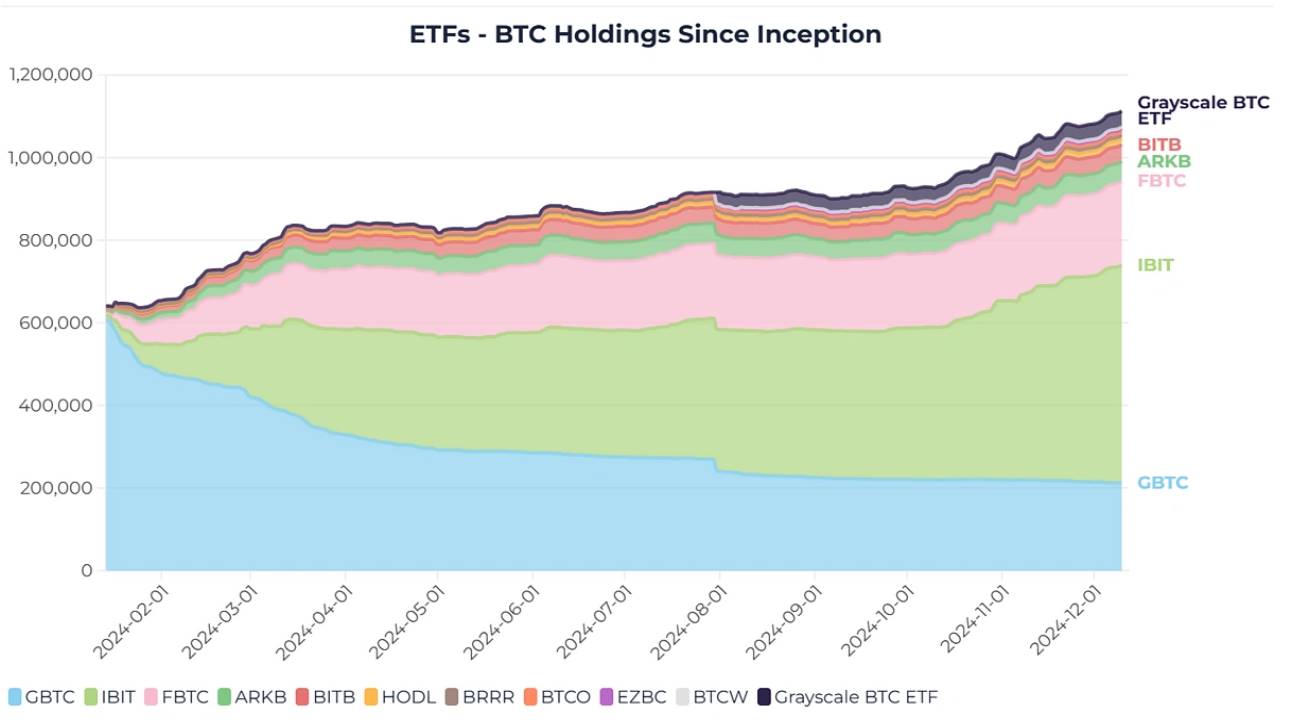
In 2024, the approval of Bitcoin and Ethereum ETFs became a milestone event in the cryptocurrency market, significantly boosting institutional participation. The long-awaited approval of a spot Bitcoin ETF by the U.S. Securities and Exchange Commission (SEC) finally became a reality, allowing traditional investors to access Bitcoin within a regulated and convenient framework. This approval led to a massive influx of institutional capital, and Bitcoin's price surged significantly following the announcement.
Similarly, the approval of the Ethereum ETF elevated Ethereum's status as a significant investment asset. With the SEC approving a spot Ethereum ETF, traditional financial institutions were able to include ETH in their portfolios, further solidifying Ethereum's position as the second-largest cryptocurrency in the world.
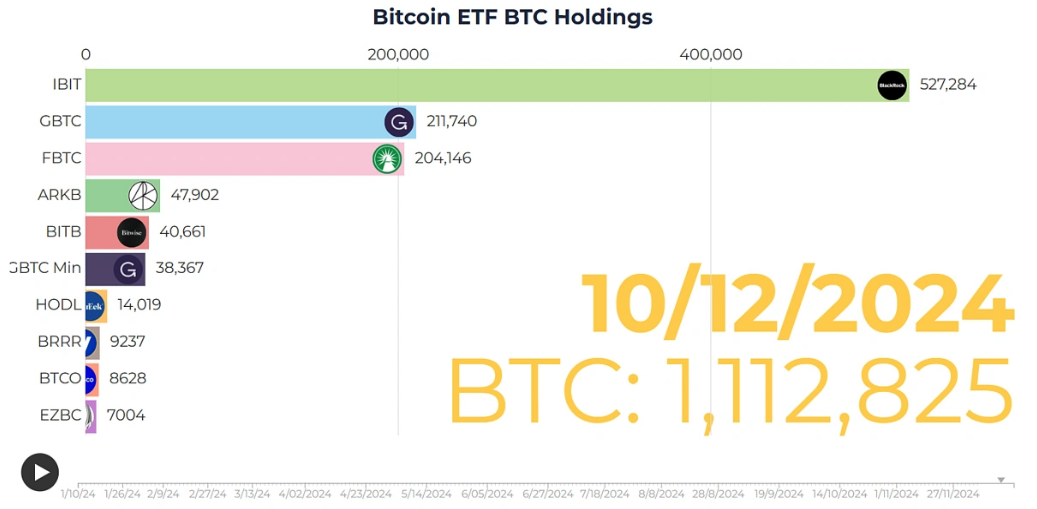
Recent data shows that institutional investors currently hold about 20% of all Bitcoin ETFs traded on U.S. exchanges. Although BlackRock's iShares Bitcoin Trust ETF (IBIT) has an institutional adoption rate below average at just 18.38%, it leads in total Bitcoin holdings, exceeding 71,000 BTC. Grayscale's GBTC follows closely, with institutional holdings of 44,707.89 BTC, accounting for 20.25% of its shareholders; while Fidelity's FBTC ranks third, with institutional holdings of 44,623.23 BTC and an institutional ownership ratio of 24.14%.
ARK 21Shares' ARKB stands out with the highest institutional adoption rate, with 32.8% of its shares held by asset managers, equivalent to 17,166 BTC. In contrast, Grayscale's Bitcoin Mini Trust has the lowest institutional participation at just 1.52%; CoinShares Valkyrie ETF (BRRRR) ranks lowest in terms of institutional Bitcoin holdings, with only 451.26 BTC.
Leaked information indicates that the world's largest asset management company, BlackRock, is negotiating to acquire shares of the Bitcoin spot ETF "King."
These approvals have opened the door for future ETF applications for other cryptocurrencies. Currently, the SEC is reviewing over 10 ETF applications, including assets like Solana (SOL) and XRP, indicating that institutional interest in a broader range of digital assets is likely to expand further. These developments could drive further adoption and price momentum across the cryptocurrency market.
3) Trump's Presidential Election Victory

Donald Trump's victory in 2024 proved to be a game changer for the cryptocurrency market. Trump's supportive stance on cryptocurrencies and his public discussions about using Bitcoin as a potential tool for repaying U.S. debt significantly boosted market confidence. This bold vision aligns with his broader policy agenda of supporting business and deregulation, igniting optimism among traders and institutional investors.
Following the election victory, Bitcoin broke through the $100,000 mark. Investors anticipate that the Trump administration will adopt cryptocurrency-friendly policies, promoting further adoption and fostering innovation in the blockchain space. His victory also sparked discussions about integrating cryptocurrencies into a broader economic framework, creating a favorable environment for the flourishing of digital assets.
2. Key Events to Watch in 2025
1) Bitcoin as a Global Economic Policy Tool
One of the most striking developments is the discussion about using Bitcoin as a tool for repaying U.S. debt. This bold idea was first proposed during Trump's campaign and has gradually gained support, attracting global attention. Trump has also expressed support for creating a "strategic Bitcoin reserve" similar to the gold reserves currently held by the Federal Reserve. This reserve could serve as an alternative asset to address sovereign debt challenges, showcasing Bitcoin's potential as a legitimate reserve asset.
The U.S. sovereign debt crisis, driven by record-high borrowing and ongoing fiscal imbalances, has prompted policymakers to explore unconventional solutions. Proponents argue that holding Bitcoin as a reserve could hedge against inflation and diversify the nation's financial toolbox, allowing for debt repayment without devaluing the dollar.
At the national level, following El Salvador's groundbreaking initiative, countries like Tonga, Paraguay, and Panama are considering adopting Bitcoin as legal tender. Driven by factors such as economic opportunity, financial inclusion, and remittance efficiency, these countries hope to leverage the potential of cryptocurrencies to modernize their financial systems and attract global investment.
Additionally, Binance founder Changpeng Zhao stated that it is inevitable for China to create a strategic Bitcoin reserve. He noted that while China's cryptocurrency policy is unpredictable, the country can make swift decisions in this area. Zhao emphasized that if other countries begin to establish Bitcoin reserves, China may follow suit to maintain its leading position in global financial competition.
Large companies like Amazon and Microsoft are also receiving inquiries from shareholders about investing a portion of their company reserves in Bitcoin. Although Microsoft's shareholders voted against including Bitcoin on the balance sheet based on the board's recommendation, their involvement in related discussions marks a shift among large companies exploring potential Bitcoin use cases, laying the groundwork for broader adoption in the coming years.
2) Approval of Other Cryptocurrency ETFs
Building on the success of Bitcoin and Ethereum ETFs, 2025 could become a turning point for other cryptocurrency ETFs, including Solana (SOL) and XRP. Although the SEC previously rejected the application for a Solana ETF, it is still reviewing over 10 applications, indicating ongoing interest in expanding crypto-based investment options.
This continued review leaves room for optimism, as market maturation and regulatory clarity may pave the way for approvals, enhancing market liquidity and investor confidence.
3) Widespread Adoption of Real-World Assets (RWA)
By 2025, the trend of tokenizing real-world assets (RWA) is expected to accelerate, fundamentally changing the interaction between traditional finance and blockchain technology. Real estate, commodities, and even artworks are being transformed into blockchain-based tokens, enabling fractional ownership and broader accessibility.
According to CoinGecko, tokenization has the potential to unlock trillions of previously illiquid assets, allowing these assets to be traded within the crypto ecosystem. This transformation bridges traditional finance and digital finance, providing investors with new diversification channels while driving innovation across various industries.
4) End of the Halving Cycle
Historically, the cycles following Bitcoin halving typically lead to prolonged price increases, often lasting up to a year (approximately 365 days). This trend suggests that the first quarter of 2025 will be dominated by the residual effects of the 2024 halving event, driving market optimism and pushing prices higher. The halving reduces miners' rewards, creating supply constraints and increasing demand, thereby creating a favorable environment for Bitcoin's growth. This effect is expected to last until April 2025, providing ample opportunities for investors and traders.
3. Predictions for 2025: Outlook for the Crypto Market
1) Bitcoin Predictions
Based on the strong momentum of 2024 and the anticipated key events of 2025, Bitcoin's growth trajectory looks very promising. A logarithmic analysis of Bitcoin's monthly chart shows that Bitcoin is moving steadily within an upward channel. Currently, Bitcoin is approaching a key axis point within this channel, similar to past bull market cycles.
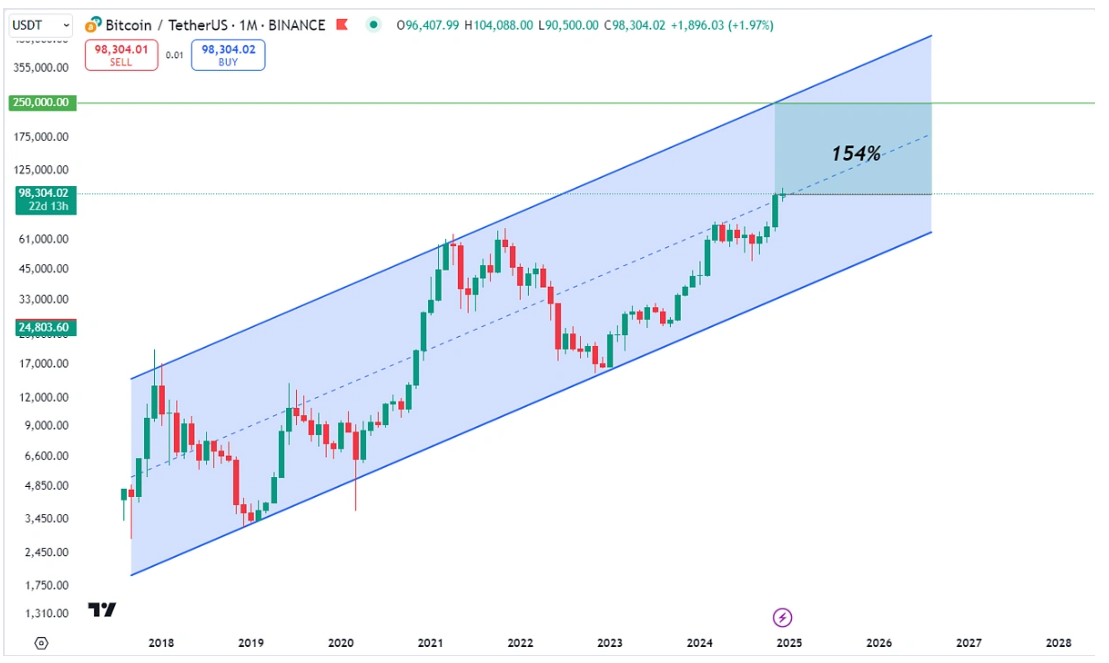
Optimistic predictions suggest that Bitcoin could reach the upper boundary of this channel, reflecting a potential value increase of 154%. This trend aligns with historical post-halving movements, where Bitcoin's price could reach $250,000, further solidifying its position as a leader in the crypto market.
2) Total Cryptocurrency Market Capitalization Predictions
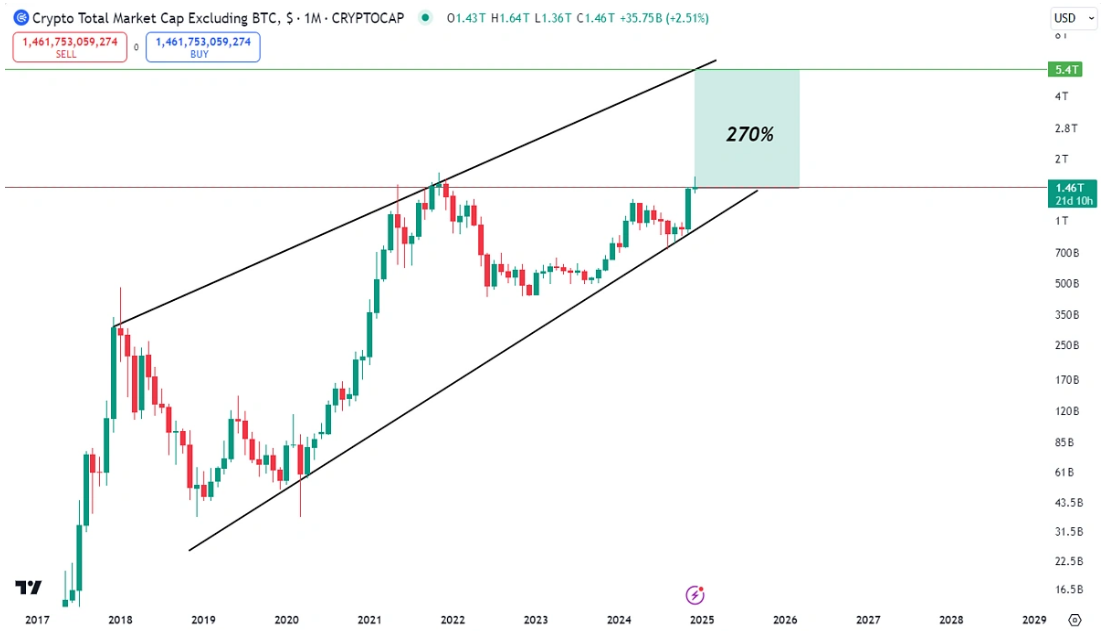
The total cryptocurrency market capitalization shows strong bull market momentum and is currently in an ascending wedge pattern. Historically, rebounds in bull market cycles typically target the upper boundary of this structure. With the current rebound from the lower trend line, the upper boundary is expected to be $3.4 trillion, representing a potential growth of 270%.
3) Total Market Capitalization Prediction Excluding the Top Ten Cryptocurrencies
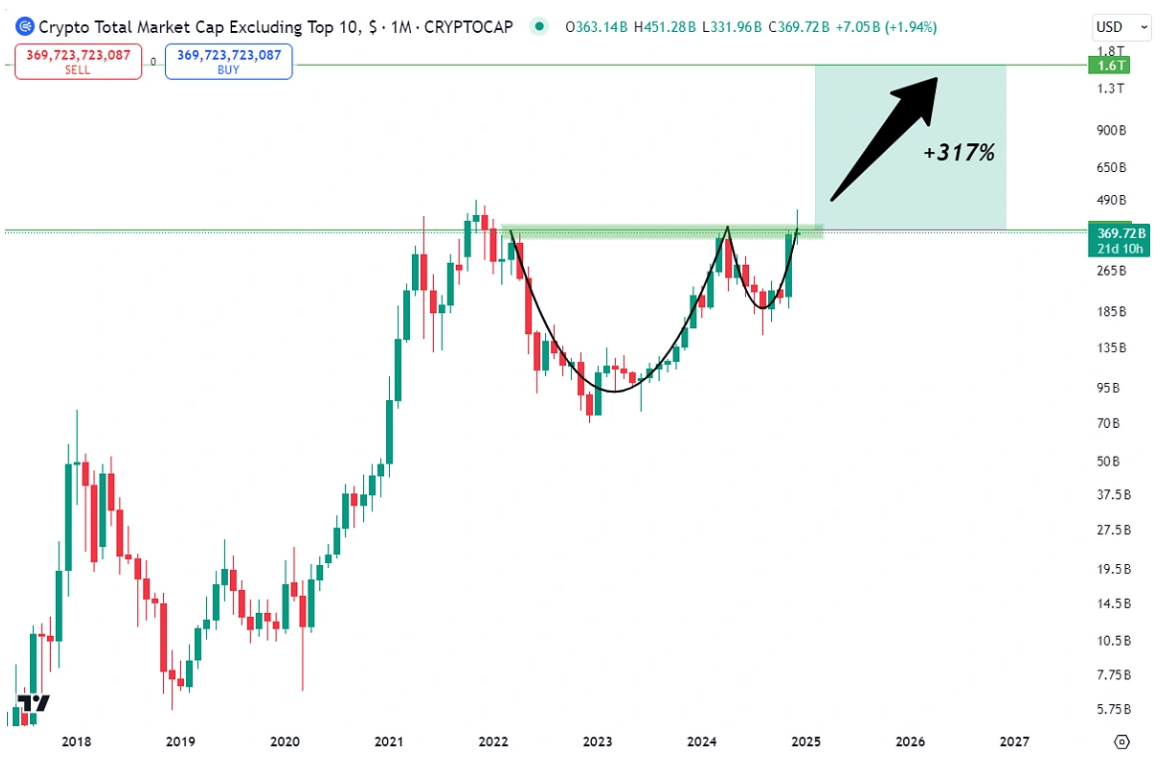
Meanwhile, the total market capitalization excluding the top ten cryptocurrencies has formed a classic "cup and handle" pattern on the monthly chart. The market is currently testing the resistance level of $370 billion. If this key level is broken, it could trigger a 317% increase, with a potential target of $1.6 trillion, marking the beginning of a strong altcoin season.
4. Conclusion
The cryptocurrency market is expected to achieve significant growth in 2025, thanks to important milestones in 2024, such as the Bitcoin halving rebound, ETF approvals, and Trump's supportive policies for cryptocurrencies. As Bitcoin potentially integrates into the economic framework, altcoin adoption increases, and real-world assets are tokenized, the market is at the forefront of innovation and expansion. Despite facing regulatory challenges, the outlook remains optimistic, with Bitcoin likely to reach new highs and the crypto ecosystem poised to reshape traditional finance.
免责声明:本文章仅代表作者个人观点,不代表本平台的立场和观点。本文章仅供信息分享,不构成对任何人的任何投资建议。用户与作者之间的任何争议,与本平台无关。如网页中刊载的文章或图片涉及侵权,请提供相关的权利证明和身份证明发送邮件到support@aicoin.com,本平台相关工作人员将会进行核查。




